3-D Numerical Investigation on Oxygen Transfer in a Horizontal Venturi Flow with Two Holes
Abstract
:1. Introduction
2. Materials and Methods
2.1. Experimental Setup and Instrumentation
2.2. Experimental Procedure and Phenomena
2.3. Governing Equations
2.4. Initial and Boundary Conditions
2.5. Numerical Details
2.6. Model Validation
3. Results and Discussion
3.1. Effect of Hydraulic Parameters
3.2. Effect of Geometric Parameters
3.3. A Correlation for the Relative Saturation Coefficient
4. Conclusions
Acknowledgments
Author Contributions
Conflicts of Interest
References
- Neilan, R.M.; Rose, K. Simulating the effects of fluctuating dissolved oxygen on growth, reproduction, and survival of fish and shrimp. J. Theor. Biol. 2014, 343, 54–68. [Google Scholar] [CrossRef] [PubMed]
- Alp, E.; Melching, C.S. Allocation of supplementary aeration stations in the Chicago waterway system for dissolved oxygen improvement. J. Environ. Manag. 2011, 92, 1577–1583. [Google Scholar] [CrossRef] [PubMed]
- McGinnis, D.F.; Lorke, A.; Wüest, A.; Stöckli, A.; Little, J.C. Interaction between a bubble plume and the near field in a stratified lake. Water Resour. Res. 2004, 40. [Google Scholar] [CrossRef]
- Lima Neto, I.E.; Zhu, D.Z.; Rajaratnam, N.; Yu, T.; Spafford, M.; McEachern, P. Dissolved oxygen downstream of an effluent outfall in an Ice-Covered River: Natural and artificial aeration. J. Environ. Eng. ASCE 2007, 133, 1051–1060. [Google Scholar] [CrossRef]
- Liu, K.; Lu, H.F.; Guo, X.L.; Sun, X.L.; Tao, S.H.; Gong, X. Experimental study on flow characteristics and pressure drop of gas-coal mixture through venture. Powder Technol. 2014, 268, 401–411. [Google Scholar] [CrossRef]
- Ashrafizadeh, S.M.; Ghassemi, H. Experimental and numerical investigation on the performance of small-sized cavitating venturis. Flow Meas. Instrum. 2015, 42, 6–15. [Google Scholar] [CrossRef]
- Monni, G.; Salve, M.E.; Panella, B. Two-phase flow measurements at high void fraction by a Venturi meter. Prog. Nucl. Energy 2014, 77, 167–175. [Google Scholar] [CrossRef]
- Abdulaziz, A.M. Performance and image analysis of a cavitating process in a small type venture. Exp. Therm. Fluid Sci. 2014, 53, 40–48. [Google Scholar] [CrossRef]
- He, D.J.; Bai, B.F. Numerical investigation of wet gas flow in Venturi meter. Flow Meas. Instrum. 2012, 28, 1–6. [Google Scholar] [CrossRef]
- Baylar, A.; Ozkan, F. Applications of Venturi principle to water aeration systems. Environ. Fluid Mech. 2006, 6, 341–357. [Google Scholar] [CrossRef]
- Baylar, A.; Ozkan, F.; Unsal, M. On the use of Venturi tubes in aeration. Clean-Soil Air Water 2007, 35, 183–185. [Google Scholar] [CrossRef]
- Baylar, A.; Aydin, M.C.; Unsal, M.; Ozkan, F. Numerical modeling of Venturi flows for determining air injection rates using FLUENT V6.2. Math. Comput. Appl. 2009, 14, 97–108. [Google Scholar] [CrossRef]
- Mantha, R.; Taylor, K.E.; Biswas, N.; Bewtra, J.K. A Continuous system for Fe0 reduction of nitrobenzene in synthetic waste water. Environ. Sci. Technol. 2001, 35, 3231–3236. [Google Scholar] [CrossRef] [PubMed]
- Yin, Z.G.; David, Z.Z.; Liang, B.C.; Wang, L. Theoretical analysis and experimental study of oxygen transfer under regular and non-breaking waves. J. Hydrodyn. 2013, 25, 718–724. [Google Scholar] [CrossRef]
- Torti, E.; Sibilla, S.; Raboni, M. An Eulerian-Lagrangian method for the simulation of the oxygen concentration dissolved by a two-phase turbulent jet system. Comput. Struct. 2013, 129, 207–217. [Google Scholar] [CrossRef]
- Wörner, M. A Compact Introduction to the Numerical Modeling of Multi-Phase Flows; Institute für Reaktorsicherheit—Program Nuvkleare Sicherheitsfotschung; Springer: Berlin, Germany, 2003. [Google Scholar]
- Yakhot, V.; Orszag, S.A. Renormalization-Group analysis of turbulence. Phys. Rev. Lett. 1986, 57, 1722. [Google Scholar] [CrossRef] [PubMed]
- Chen, Q. Comparison of different k-ε models for indoor air flow computations. Numer. Heat Transf. B Fund. 1995, 28, 353–369. [Google Scholar] [CrossRef]
- Faghri, A.; Zhang, Y.; Howell, J. Advanced Heat and Mass Transfer; Global Digital Press: Colombia, MO, USA, 2010. [Google Scholar]
- Yin, Z.G.; Cheng, D.S.; Liang, B.C. Oxygen transfer by air injection in horizontal pipe flow. J. Environ. Eng. ASCE 2012, 139, 908–912. [Google Scholar] [CrossRef]
- Geldert, D.A.; Gulliver, J.S.; Wilhelms, S.C. Modeling dissolved gas supersaturation below spillway plunge pools. J. Hydraul. Eng. ASCE 1998, 124, 513–521. [Google Scholar] [CrossRef]
- Wilkinson, P.M.; Haringa, H.; Van Dierendonck, L.L. Mass transfer and bubble size in a bubble column under pressure. Chem. Eng. Sci. 1994, 49, 1417–1427. [Google Scholar] [CrossRef]
- Rosso, D.; Larson, L.E.; Stenstrom, M.K. Surfactant effects on alpha factors in full-scale wastewater aeration systems. Water Sci. Technol. 2006, 54, 143–153. [Google Scholar] [CrossRef] [PubMed]
- Laborde-Boutet, C.; Larachi, F.; Dromard, N.; Delsart, O.; Schweich, D. CFD simulation of bubble column flows: Investigations on turbulence models in RANS approach. Chem. Eng. Sci. 2009, 64, 4399–4413. [Google Scholar] [CrossRef]
- Lide, D.R. CRC Handbook of Chemistry and Physics, 87th ed.; Internet Version; CRC Press/Taylor and Francis Group: Boca Raton, FL, USA, 2007. [Google Scholar]
- Lamont, J.C.; Scott, D.S. An eddy cell model of mass transfer into the surface of a turbulent liquid. AIChE J. 1970, 16, 513–519. [Google Scholar] [CrossRef]
- Politano, M.; Arenas Amado, A.; Bickford, S.; Murauskas, J.; Hay, D. Investigation into the total dissolved gas dynamics of wells dam using a two-phase flow model. J. Hydraul. Eng. 2010, 137, 1257–1268. [Google Scholar] [CrossRef]
- Richardson, L.F.; Gaunt, J.A. The deferred approach to the limit. Part I. Single lattice. Part II. Interpenetrating lattices. Philos. Trans. R. Soc. Lond. Ser. A Contain. Pap. Math. Phys. Character 1927, 226, 299–361. [Google Scholar] [CrossRef]
- Ferziger, J.H.; PERIĆ, M. Further discussion of numerical errors in CFD. Int. J. Numer. Methods Fluids 1996, 23, 1263–1274. [Google Scholar] [CrossRef]
- Broadhead, B.L.; Rearden, B.T.; Hopper, C.M.; Wagschal, J.J.; Parks, C.V. Sensitivity-and uncertainty-based criticality safety validation techniques. Nucl. Sci. Eng. 2004, 146, 340–366. [Google Scholar] [CrossRef]
- Celik, I.B.; Ghia, U.; Roache, P.J. Procedure for estimation and reporting of uncertainty due to discretization in CFD applications. J. Fluids Eng. 2008, 130, 078001. [Google Scholar]
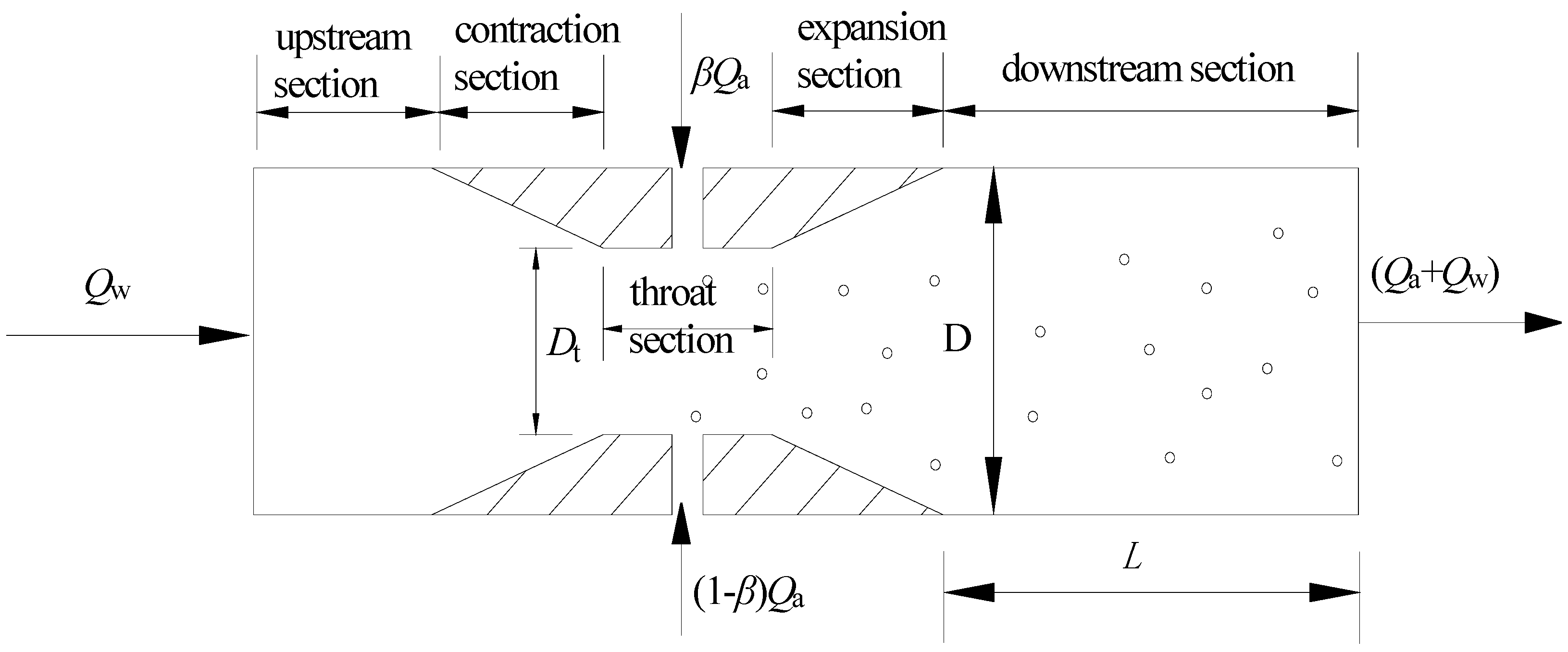
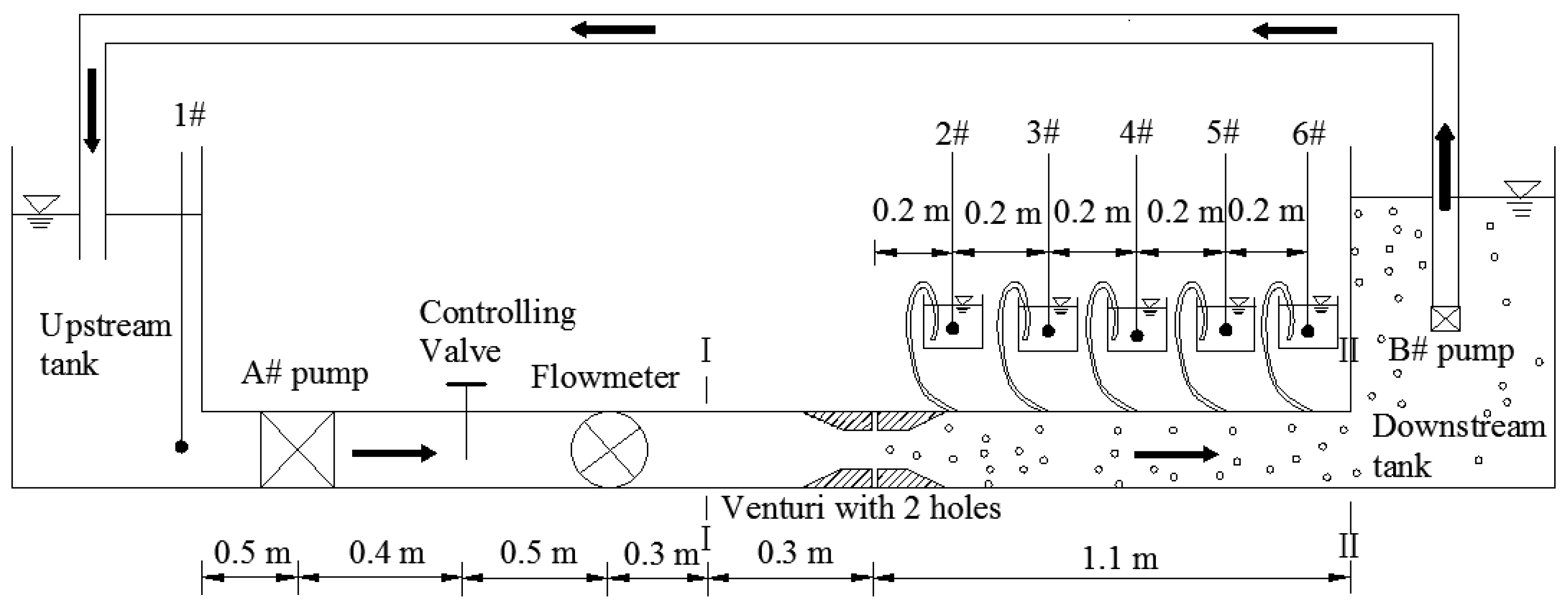
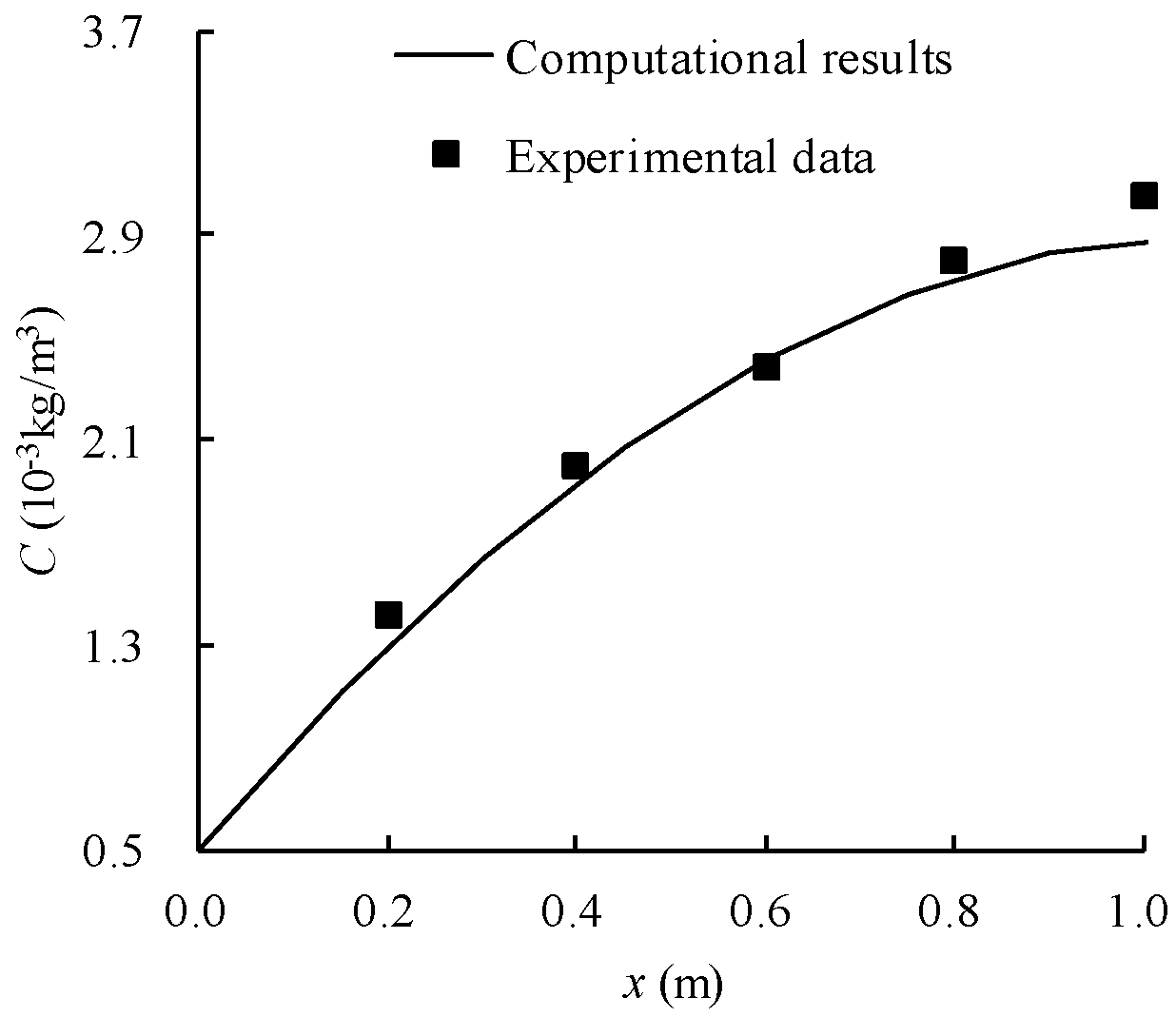
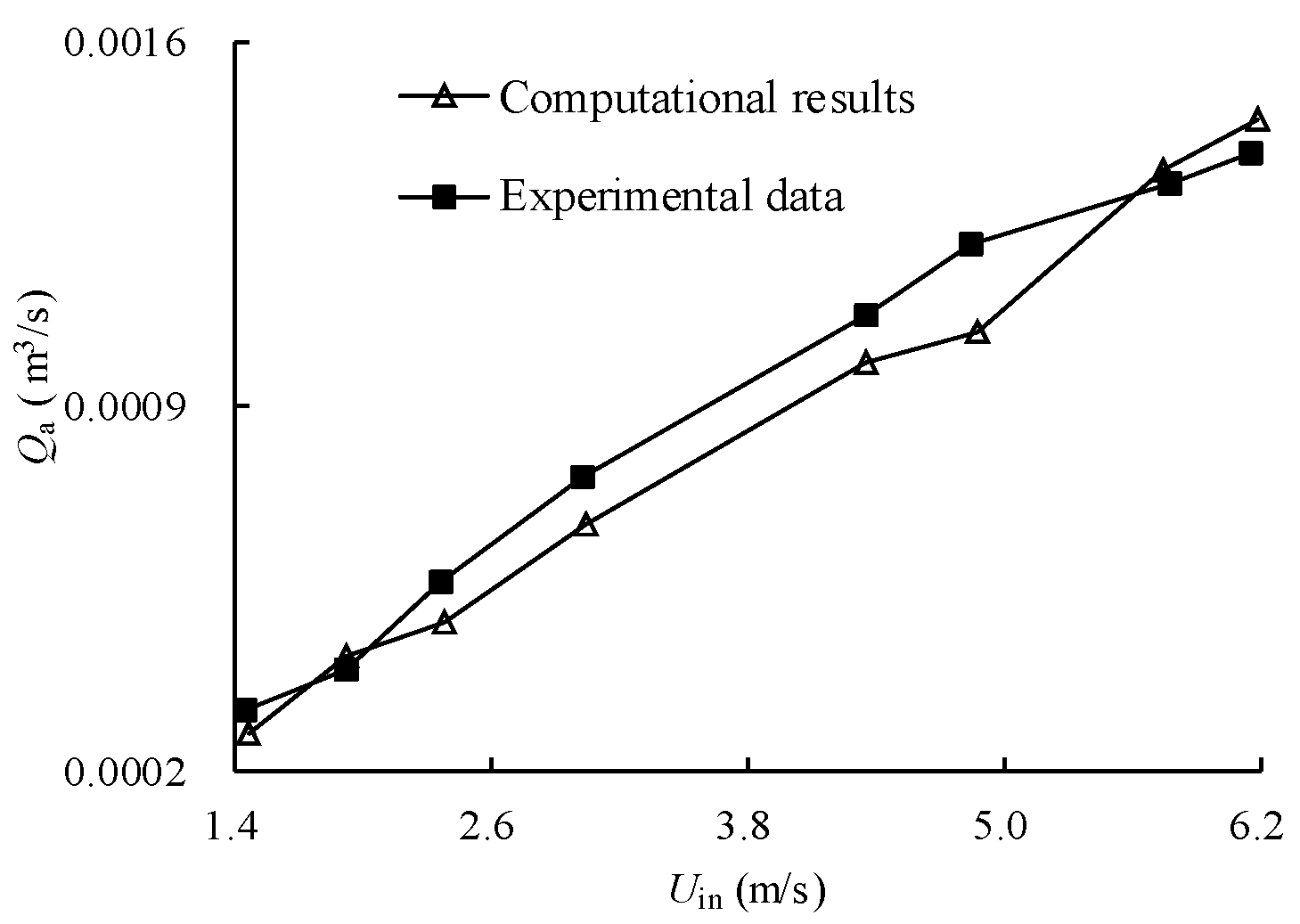



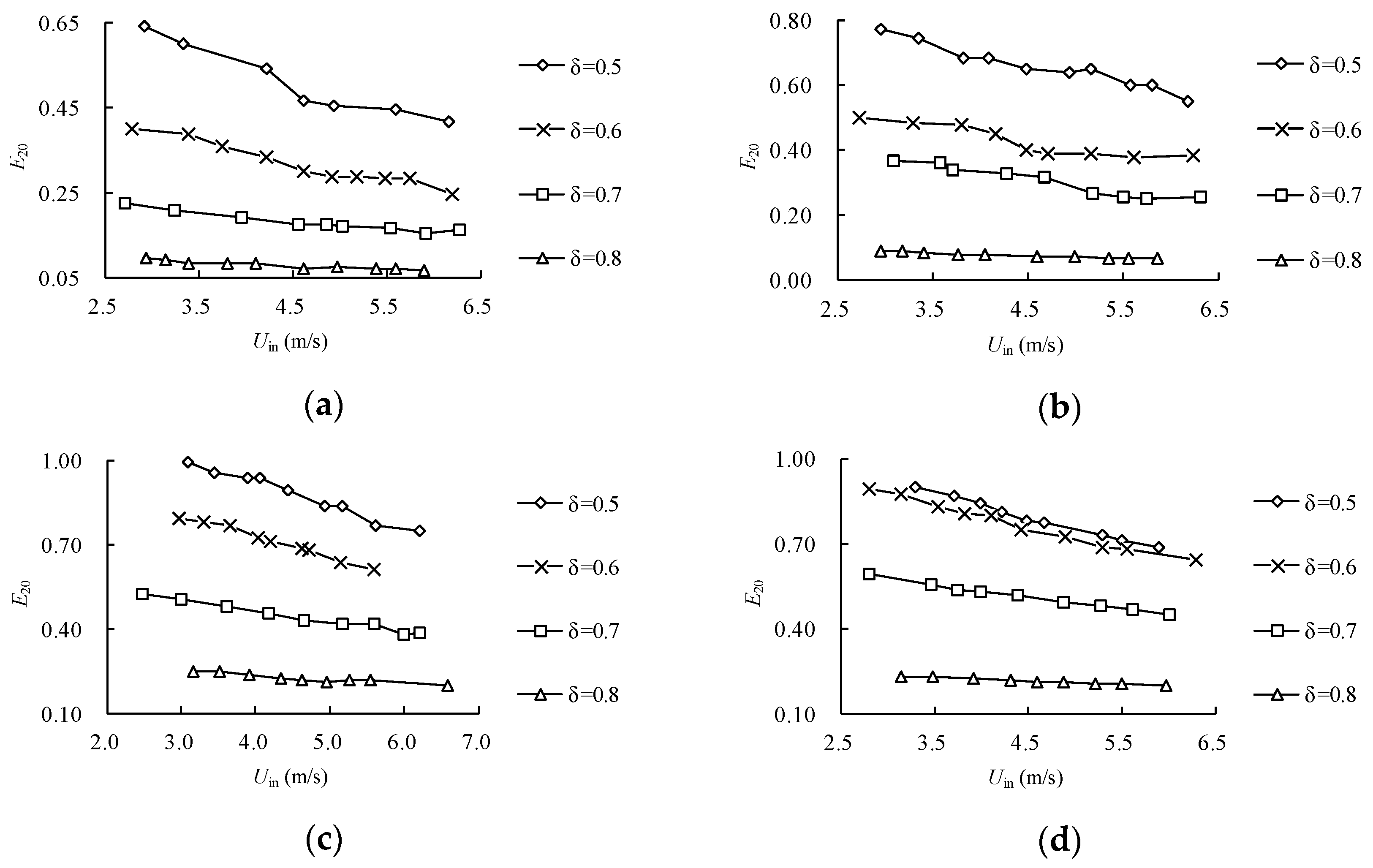
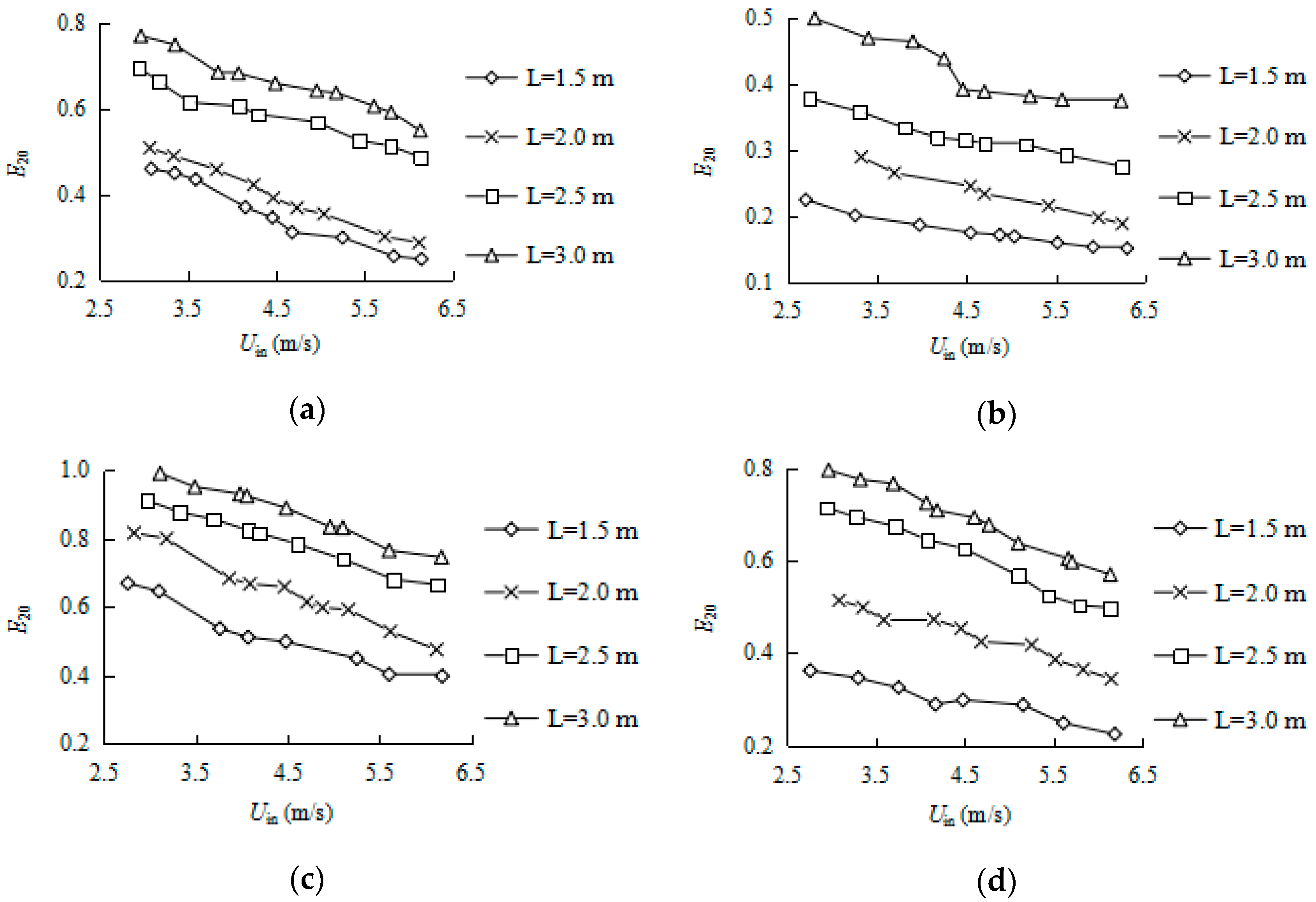
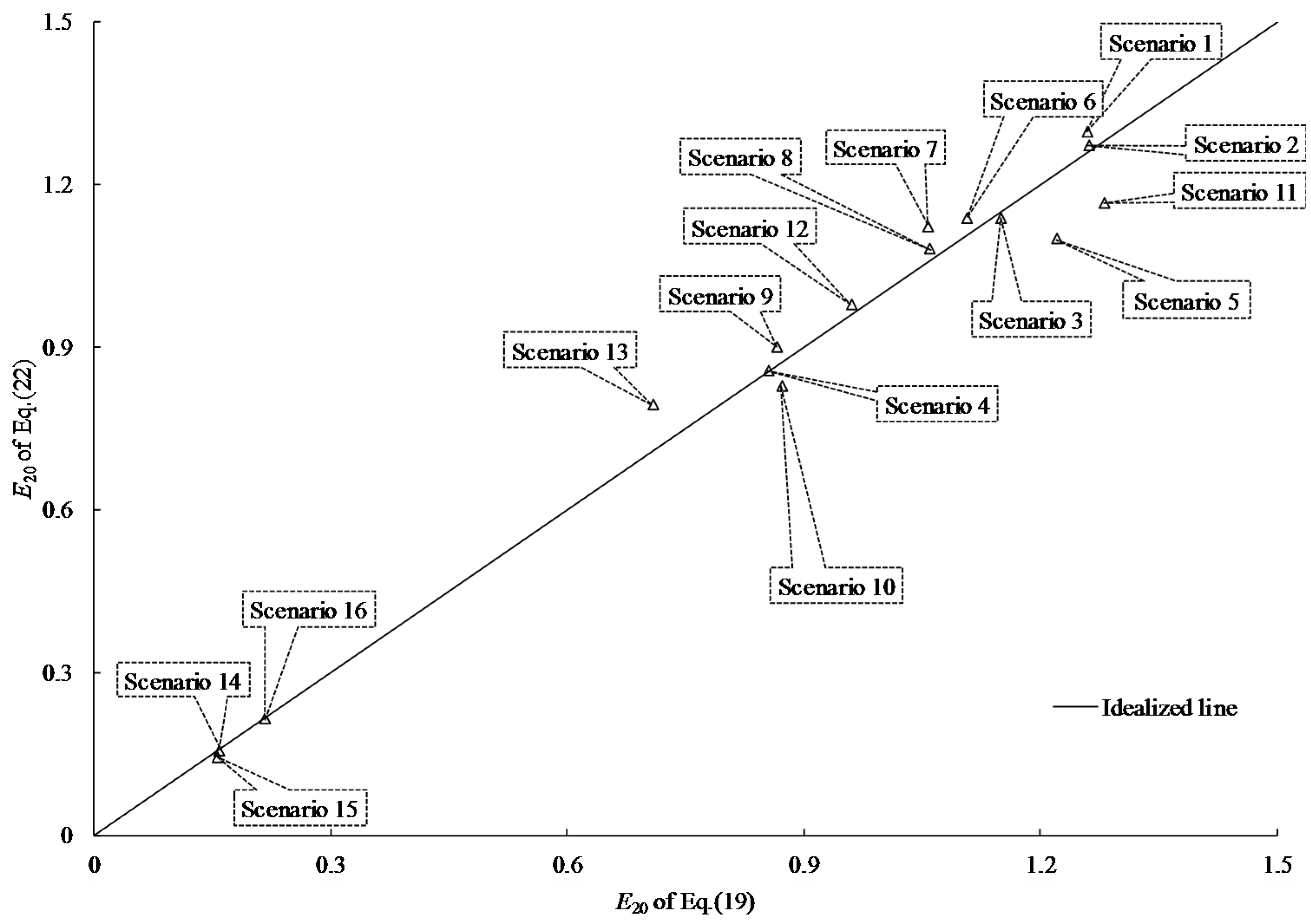
| Grid | At the Centre of the 2 Holes Cross Section for Qw = 2.05 × 10−4 m3/s and Cin = 5 × 10−4 kg/m3 | ||
|---|---|---|---|
| Grid Partition Scheme | Total Cells Number | Refined Cells Number | Water Velocity |
| Grid 1 | 3,640,723 | 1,383,413 | 31.86 m/s |
| Grid 2 | 457,235 | 172,919 | 31.37 m/s |
| Grid 3 | 40,154 | 18,396 | 35.47 m/s |
| Extrapolated values | 32.35 m/s | ||
| Extrapolated relative error | 1.5% | ||
| Grid convergence index | 1.9% | ||
| Scenarios | Uin (m/s) | Cin (10−3 kg/m3) | d (m) | L (m) | δ |
|---|---|---|---|---|---|
| 1 | 5.54 | 0 | 0.030 | 3 | 0.5 |
| 2 | 5.92 | 0 | 0.030 | 3 | 0.5 |
| 3 | 6.39 | 1 | 0.030 | 3 | 0.6 |
| 4 | 5.29 | 0 | 0.025 | 2 | 0.5 |
| 5 | 9.00 | 2 | 0.030 | 3 | 0.6 |
| 6 | 7.51 | 2 | 0.020 | 3 | 0.5 |
| 7 | 4.33 | 3 | 0.030 | 3 | 0.7 |
| 8 | 5.01 | 3 | 0.030 | 3 | 0.7 |
| 9 | 6.06 | 4 | 0.030 | 2 | 0.7 |
| 10 | 7.42 | 4 | 0.030 | 2 | 0.7 |
| 11 | 5.06 | 5 | 0.020 | 3 | 0.5 |
| 12 | 4.17 | 5 | 0.015 | 3 | 0.6 |
| 13 | 6.31 | 5 | 0.015 | 2 | 0.6 |
| 14 | 6.35 | 1 | 0.020 | 2 | 0.8 |
| 15 | 5.50 | 1 | 0.020 | 2 | 0.8 |
| 16 | 5.29 | 2 | 0.020 | 2 | 0.8 |
© 2018 by the authors. Licensee MDPI, Basel, Switzerland. This article is an open access article distributed under the terms and conditions of the Creative Commons Attribution (CC BY) license (http://creativecommons.org/licenses/by/4.0/).
Share and Cite
Yin, Z.; Feng, Y.; Wang, Y.; Gao, C.; Ma, N. 3-D Numerical Investigation on Oxygen Transfer in a Horizontal Venturi Flow with Two Holes. Water 2018, 10, 174. https://doi.org/10.3390/w10020174
Yin Z, Feng Y, Wang Y, Gao C, Ma N. 3-D Numerical Investigation on Oxygen Transfer in a Horizontal Venturi Flow with Two Holes. Water. 2018; 10(2):174. https://doi.org/10.3390/w10020174
Chicago/Turabian StyleYin, Zegao, Yingnan Feng, Yanxu Wang, Chengyan Gao, and Ningning Ma. 2018. "3-D Numerical Investigation on Oxygen Transfer in a Horizontal Venturi Flow with Two Holes" Water 10, no. 2: 174. https://doi.org/10.3390/w10020174
APA StyleYin, Z., Feng, Y., Wang, Y., Gao, C., & Ma, N. (2018). 3-D Numerical Investigation on Oxygen Transfer in a Horizontal Venturi Flow with Two Holes. Water, 10(2), 174. https://doi.org/10.3390/w10020174





